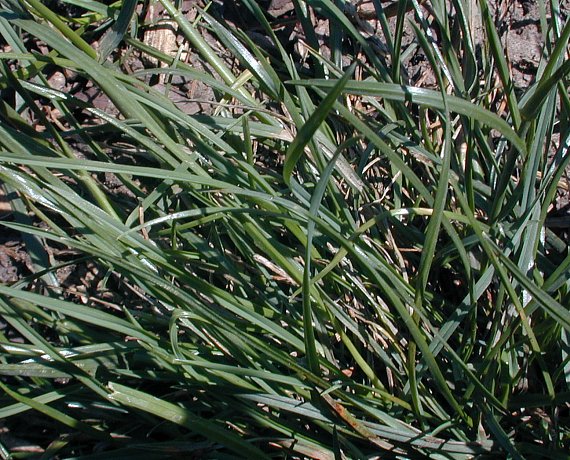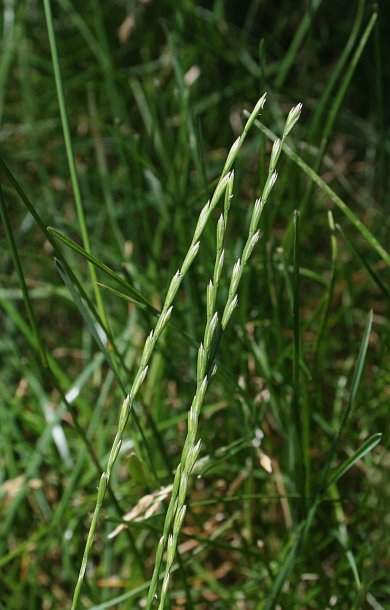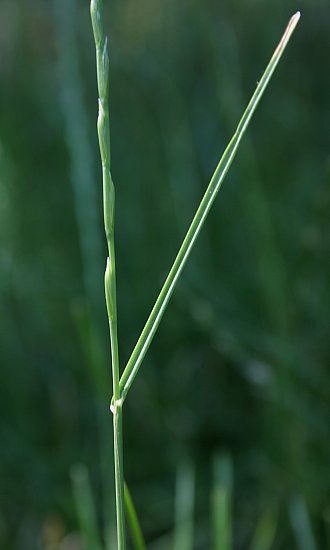Description: This grass is a short-lived perennial that produces either a solitary culm or small tuft of leafy culms about ¾–2' tall. Both fertile and shorter infertile shoots are present. The culms are light green, hairless, and terete to slightly compressed (subterete). On each fertile culm, the leaves mostly occur along the lower one-third of its length, where they are alternate. The leaf blades are 2-5 mm. across and up to 6" long; they are medium to dark green, hairless, and ascending to widely spreading. The leaf blades are furrowed above and keeled below; they have whitened auricles (ear-like basal lobes) at their bases that clasp the culms. The leaf sheaths wrap tightly around their culms; they are medium green, hairless, and open. However, the lowermost sheaths may become tan to reddish brown and disintegrate with age. The ligules are short-membranous, while the nodes are swollen and glabrous. Each fertile culm terminates in a flowering spike about 4-10" long. This spike consists of several sessile spikelets that alternate along two sides of the rachis (central stalk of the spike). The rachis is slightly indented where each spikelet occurs, providing it with a curvilinear zigzag appearance.

Each non-terminal spikelet is 8-16 mm. in length, consisting of a single outer glume at its base and 4-10 lemmas that are arranged in 2 overlapping ranks. The lemmas are 4-7 mm. in length, oblong in shape, convex along their outer surfaces, longitudinally veined, and hairless. The floret of each fertile lemma consists of an ovary, a pair of feathery stigmata, and 3 stamens. The outer glume is longer than individual lemmas, but shorter than the spikelet. Aside from its greater length, the glume is similar in appearance to the lemmas. Terminal spikelets are the same as non-terminal spikelets, except they have 2 glumes; these glumes are similar to the outer glumes of the non-terminal spikelets. As the spikelets mature, they change in color from light green to light tan. The blooming period typically occurs during early summer, although this may be delayed by disturbance. The florets are cross-pollinated by the wind. Afterwards, the florets of fertile lemmas are replaced by grains. At maturity, these grains are 3-5.5 mm. long, narrowly oblongoid in shape, narrowly grooved along one side, and light tan. Disarticulation of the spikelets is above the glumes. The root system consists of a tuft of shallow fibrous roots. This grass reproduces by reseeding itself.

Cultivation:
The preference is full sun, moist to dry-mesic conditions, and
fertile soil containing loam or clay-loam. English Ryegrass dies down
during the summer if the weather is hot and dry, and this grass is
vulnerable to winter-kill if it is exposed to severe winter cold
without a protective layer of snow. Open areas are preferred where
there is
reduced competition from other kinds of ground vegetation. Regular
mowing is tolerated. To start new plants, the seeds should be planted
during the spring; they do not require pretreatment in order to
germinate.
Range & Habitat:
English Ryegrass has been collected in most counties of Illinois (see Distribution
Map); this grass has probably naturalized in every
county of the state. It was introduced from Europe into the United
States as a source of forage and hay for farm animals.
Habitats include lawns, vacant lots, fallow fields, pastures, grassy
areas along roadsides and railroads, and open waste areas. Areas with a
history of disturbance are preferred. English Ryegrass is often
cultivated as a lawn grass in conjunction with Kentucky Bluegrass (Poa
pratensis) and other turf grasses. It often escapes into
adjacent areas, including lawns where it wasn't originally introduced.

Faunal
Associations:
Insects that feed feed on the leaves, roots, and other parts of
ryegrasses (Lolium spp.)
include Oulema melanopus
(Cereal Leaf Beetle),
Sphenophorus parvulus
(Bluegrass Billbug),
Cyclocephala borealis
(Northern Masked Chafer), Blissus
leucopterus hirtus (Hairy Chinch
Bug), Pediasia trisecta
(Larger Sod Webworm), Nephelodes
minians
(Bronzed Cutworm), Metopolophium
dirhodum (Rose-Grass Aphid),
Rhopalosiphum padi
(Bird Cherry & Oat Aphid), and other aphids.
Normally, the foliage of English Ryegrass is palatable to many farm
animals, including cattle, sheep, goats, and horses. However, when this
grass becomes infected with an endophytic fungus (Neotyphodium lolii),
it can become toxic
and cause Ryegrass staggers.
Photographic Location:
A lawn in Urbana, Illinois.

Comments: This little grass remains green longer in the summer than Kentucky Bluegrass (Poa pratensis) and it blooms a little later. However, the airy inflorescence of Kentucky Bluegrass is very different from the narrow floral spike of English Ryegrass (Lolium perenne). Two other species, Italian Ryegrass (Lolium multiflorum) and Darnel (Lolium temulentum), are similar in appearance, but they are less common in Illinois. Italian Ryegrass is larger in size overall; it has more lemmas per spikelet (10-20) that are usually awned. Darnel differs from the preceding grass species by having glumes that are longer than than the remainder of their spikelets; each glume extends beyond the tips of the uppermost lemmas in a spikelet. Because ryegrasses (Lolium spp.) can hybridize spontaneously with each other and some cultivars of English Ryegrass are probably hybrids, it can be be difficult to identify specimens from the field. These grasses should not be confused with Wild Rye (Elymus spp.) and Cultivated Rye (Secale cereale), which are quite distinct, in spite of the similarity in their common names.